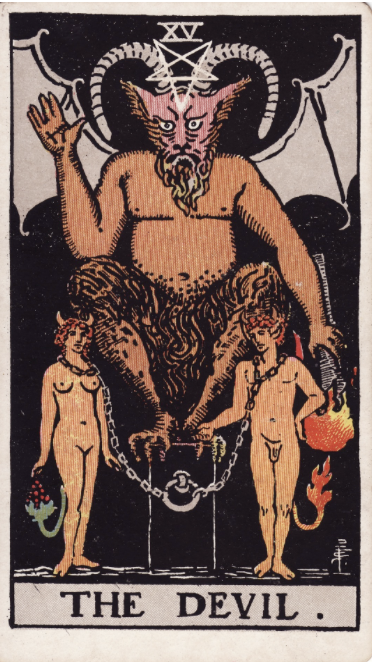The Devil – The Chains We Choose
The Devil, numbered XV in the Major Arcana, is one of the most misunderstood cards in the Tarot. Often feared or dismissed, the Devil represents not external evil, but the internal chains we willingly wear. He is the shadow made manifest, the habits we justify, the addictions we excuse, and the illusions we cling to for comfort. He stands not in opposition to divinity but in revelation of our disconnection from it.
When the Devil appears, it is a call to look at what binds us—not from a place of punishment, but with piercing honesty. He challenges us to ask: What have I given my power to? Where am I trapped in illusion? What comforts have become cages?
In my own journey, the Devil card speaks most directly to the chains of addiction. And not just addiction to substances, but to patterns of thought, emotional cycles, and especially to food and love. These were the addictions I wrote about most deeply in Enlightenment Pie. Not because I had conquered them once and for all, but because they were the mirrors in which I saw myself most clearly.
My Story: The Hungry Ghost
I used to eat to numb myself. I called it hunger, but it was longing. I wasn't feeding a body, I was feeding a wound. There was a certain kind of silence that came after a binge—a hush of shame that covered everything like a weighted blanket. And then I would do it again.
Love addiction was no different. I clung to fantasy, to texting loops, to the hope that someone would make me feel whole. The craving for love was insatiable because it was never about love at all. It was about losing myself in the hope that someone else could hold what I couldn't.
"Addiction isn't about the substance, it's about the absence."
That's what the Devil shows us. Not that we're bad or broken. But that we are avoiding the truth of our own power. We are afraid to be free, because freedom comes with responsibility.
In Enlightenment Pie, I wrote:
"The addiction to fantasy, to sugar, to longing, to attention—they're all portals to the same pain. A refusal to be with what is. A rejection of the moment."
And this is where the Devil becomes sacred. Because he doesn't let us lie to ourselves anymore.
The Deep Symbolism of the Devil
The Devil sits on a black pedestal, torch in hand, overseeing a man and woman bound by chains around their necks. But the chains are loose—they could remove them at any time. This is not captivity imposed; it is chosen.
Inverted Pentagram: Often shown above the Devil's head, symbolizing the material dominating the spiritual.
The Chains: Indicate bondage to illusion, addiction, or fear.
The Torch: A mockery of the light, used to ignite lower desires rather than higher consciousness.
Goat-Horned Figure: A blend of Baphomet and Pan—a symbol of raw instinct and primal drive.
This card is ruled by Capricorn, the sign of structure, ambition, and earthly responsibility. When distorted, this energy becomes controlling, obsessive, and rigid. But when awakened, it reminds us that we always have the power to restructure our reality.
The Devil’s Kabbalistic path is Ayin (ע), meaning "eye." It connects Tiphareth (Beauty) and Hod (Splendor). This path invites us to see through illusion—to look directly at what is distorted so we can reclaim the beauty and clarity beneath it.
The Devil in the Soul’s Evolution
The Devil appears after Temperance in the Major Arcana for a reason. After learning to walk the middle path, we are tested. Can we stay centered when the cravings return? Can we remember who we are when the illusion feels comforting?
The Devil teaches us to:
Identify our unconscious habits
Acknowledge where we’ve given away our power
Reclaim our ability to choose differently
Alchemize shame into awareness
See addiction not as weakness but as misdirected yearning
He is the card of radical self-honesty. He doesn’t ask us to be perfect. He asks us to see.
Carl Jung on the Devil Archetype
Jung would likely recognize the Devil as a pure embodiment of the Shadow. He taught that all humans carry within them a shadow—the denied, repressed, or unloved parts of ourselves. And the more we avoid the shadow, the more it controls us.
In Jungian psychology, addiction is often viewed as a symbolic relationship with the shadow. The addict is not just hooked on a substance or a person—they are hooked on escaping the self. The Devil archetype in this light becomes a powerful ally. He holds the mirror up to our compulsions, not to shame us, but to awaken us.
Jung said:
"One does not become enlightened by imagining figures of light, but by making the darkness conscious."
The Devil invites this level of consciousness. He is not the enemy. He is the confrontation that sets us free.
Conclusion: Freedom Is a Choice
We all wear chains. Some are made of gold. Some are laced with sugar. Some are scented with longing. But all of them can be released.
The Devil card does not condemn. It reveals. It shows us where we have abandoned ourselves in favor of temporary comfort. And it invites us to choose again.
To see clearly. To feel fully. To reclaim the power that was never truly lost.
So ask yourself:
What am I addicted to?
What am I avoiding?
Where am I ready to break the chain?
The Devil reminds us: liberation is not something granted. It is something claimed. And you, beloved, are already holding the key.

